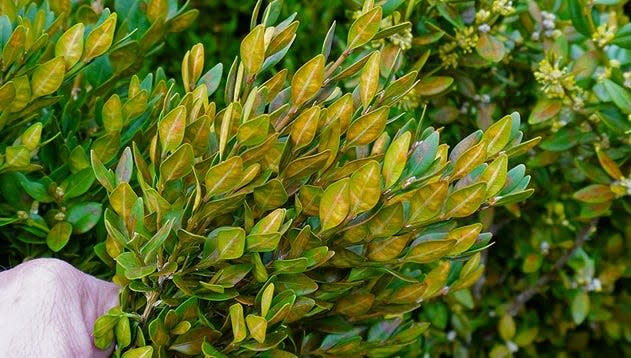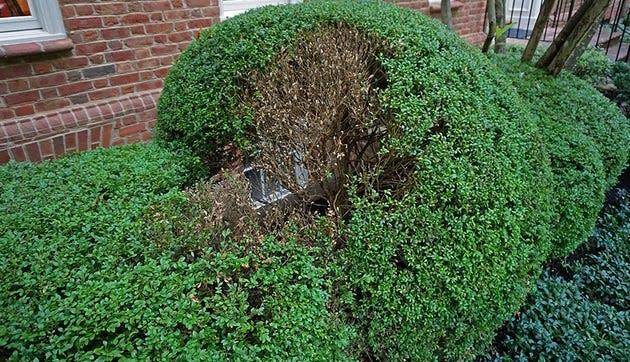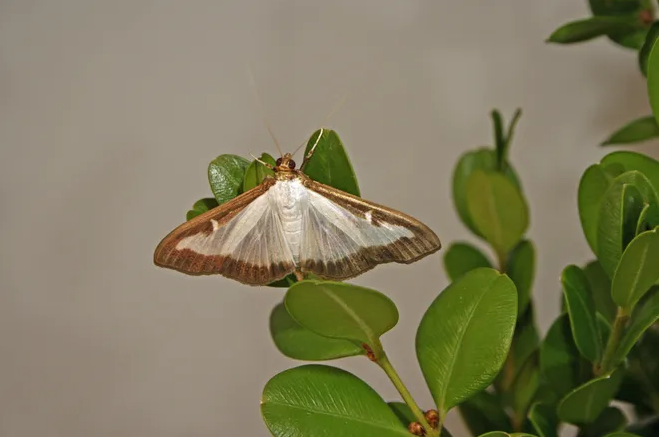Boxwood shrubs under attack from invasive species, disease

Boxwoods (Buxus spp.) are one of the most common shrubs in landscapes throughout Greater Columbus. This deer-resistant, broad-leaved evergreen shrub is typically used in foundation plantings, as a backdrop for planting beds, as topiaries, and as borders in formal gardens. There are many species and cultivars of boxwood available.
But this reliable landscape mainstay is under attack from a well-known insect of Boxwood, the vagaries of winter weather, a deadly disease, and a now a non-native insect recently identified for the first time in Ohio. Determining the culprit behind a browning boxwood can be difficult due to the similarity of the symptoms of each of these maladies.
More from Mike Hogan: Follow these tips to keep lettuce and other greens growing in the summer heat
Winter injury
Boxwood can be susceptible to winter injury from extremely cold temperatures, from prolonged periods of excessive wind, and even from salt applied close to these shrubs for ice control on sidewalks or driveways. In spring 2023, we saw the results of widespread winter injury on boxwood caused by extremely cold weather that occurred in Greater Columbus on December 23, 2022, when temperatures reached –7 degrees Fahrenheit at John Glenn International Airport.
Fortunately, boxwood typically recovers from winter injury, and many affected plants are now producing new green growth behind branches with dead foliage caused by winter injury. Dead branches can now be selectively pruned to allow the new growth to expand and eventually fill in the areas where dead branches were removed.

Boxwood leafminer
The non-native boxwood leafminer (Monarthropalpus flavus) lays eggs between the upper and lower leaf surfaces of Boxwood leaves, and when the eggs hatch in early summer, the resulting larvae feed on the inside of leaves for the remainder of the summer and again the next spring. Damage is most evident in spring when affected leaves turn brown. In early spring, damage from Boxwood leafminer can easily be confused with damage caused by winter injury.
Boxwood leafminer damage can be identified by the presence of bumps on the leaves, which develop as the larvae increase in size. Damaging Boxwood leafminer infestations can be suppressed through applications of a neonicotinoid insecticide such as imidacloprid (e.g. Merit, Marathon and generics) or dinotefuran (e.g. Safari or Zylam). Applications should be made in late summer, long after boxwoods flower, in order to protect pollinators.
More from Mike Hogan: Want summer-blooming lilies? Follow these tips to plant and grow different types

Boxwood blight
Boxwood blight is a disease that causes a severe and unusually rapid decline of susceptible boxwoods. Heavy defoliation and branch dieback can occur in a single season, killing small plants. The ornamental value of larger infected boxwoods is reduced, and plants may become so stressed that they succumb to secondary problems. Boxwood blight was first detected in the United States 12 years ago on the East Coast, and was first identified in Ohio four years ago in Cincinnati, and has been identified on boxwoods in Greater Columbus.
Boxwoods infected with boxwood blight rarely recover and typically must be removed from the landscape and destroyed. Affected boxwoods can be replaced with less susceptible varieties. Before removal, positive identification of the disease should be confirmed. Gardeners may submit samples from suspect plants to Ohio State University’s Plant and Pest Diagnostic Clinic (ppdc.osu.edu) for diagnosis.

Box Tree Moth
The Ohio Department of Agriculture (ODA) recently confirmed that the box tree moth (Cydalima perspectalis) has been found in southwest Ohio near the borders of Hamilton and Clermont Counties. This is the first time this non-native pest of boxwood has been confirmed in Ohio. This pest has not been found anywhere else in Ohio ... yet!
The caterpillar stage of the box tree moth damages boxwood by devouring leaves. Heavy infestations of the pest can cause complete defoliation of affected plants. Box tree moth caterpillars develop into very distinctive brown and tan-colored moths.
More: 4 invasive species the Ohio Department of Agriculture is worried about
The ODA has developed an online reporting tool for box tree moth with many helpful features, including an interactive map to pin the exact location of your observation. The reporting tool requires a picture, so make sure you take clear pictures that are in focus to upload with your report. The reporting tool can be found here: https://survey123.arcgis.com/share/1b36dd2cf09e4be0a79776a6104ce1dc.
Mike Hogan is an Extension Educator, Agriculture and Natural Resources, and associate professor with Ohio State University Extension. hogan.1@osu.edu.
This article originally appeared on The Columbus Dispatch: Box tree moth, boxwood leafminer attacking boxwood shrubs

